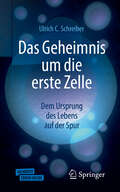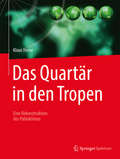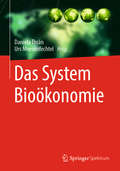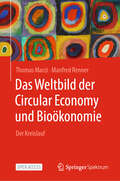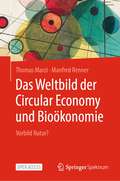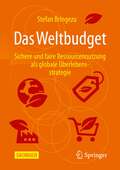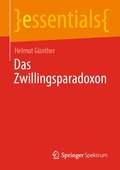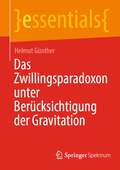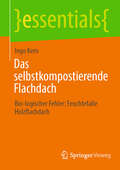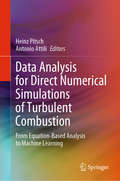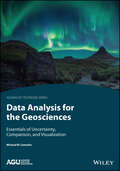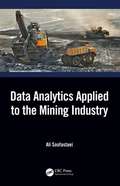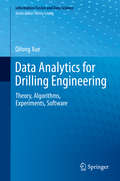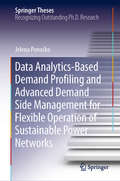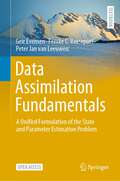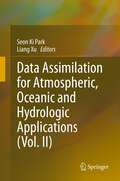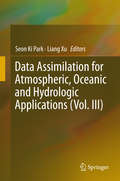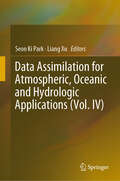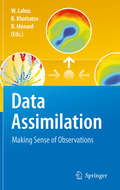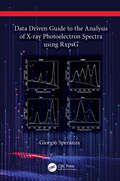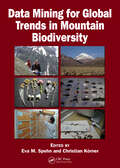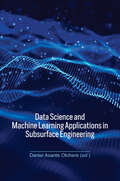- Table View
- List View
Das Geheimnis um die erste Zelle: Dem Ursprung des Lebens auf der Spur
by Ulrich C. SchreiberEine der größten Fragen der Wissenschaft steht vielleicht in naher Zukunft vor der Aufklärung. Wie ist das Leben auf der Erde entstanden? Wo genau liegt der Ursprung? Welche Schritte waren von Nöten? Und wie hängen die komplexen Vorgänge zusammen?Zahlreiche Modelle wurden bereits beschrieben, die die grundlegenden Schritte für die Bildung organischer Moleküle auf der Erde oder im Weltall erklären. Doch scheiterten diese bisher daran tatsächlich plausible Szenarien für die entscheidenden Stufen der Lebensentwicklung daraus abzuleiten. Bei allen intensiven Überlegungen wurde ein Raum, ein Ort auf der Erde, übersehen, der eine Vielzahl an Möglichkeiten für die Entstehung der ersten Zelle bereithält. Mit einem Schlag scheint dieser Raum viele Probleme auf der Suche nach dem Ursprung des Lebens zu lösen. Es sind wassergefüllte Spalten, sogenannte Bruchzonen, in der kontinentalen Erdkruste, die alle Voraussetzungen für eine komplexe organische Chemie bieten. Der Autor nimmt seine Leser mit auf seine ganz persönliche Reise hin zur Antwort auf die vielleicht größte Frage der Biologie. So erklärt er nicht nur, wie die einzelnen Puzzleteile der Entwicklung des Lebens zusammen passen, sondern berichtet über seine persönlichen Erfahrungen in diesem schwierigen Forschungsfeld. Dabei zeigt er, dass erste Laborversuche unter realistischen Bedingungen eindrucksvoll eine chemische Evolution bestimmter organischer Moleküle bestätigen. Die Versuche sind an Prozesse angelehnt, wie sie von Beginn an in der tieferen Erdkruste stattgefunden haben. Zum ersten Mal legt der Autor seine Hypothese zur Speicherung genetischer Informationen in Form der RNA der breiten Öffentlichkeit vor. Finden Sie heraus, wie alles begann.
Das Quartär in den Tropen: Eine Rekonstruktion des Paläoklimas
by Klaus HeineDas Eiszeitalter (Quartär) ist eine Zeit extremer Klimaschwankungen, die zum Anwachsen und Abschmelzen gewaltiger Eisschilde in den hohen Breiten führten. Die tropischen Wüsten, Savannen, Regenwälder und Gebirgsregionen erlebten gleichermaßen dramatische Klimaänderungen, deren Spuren in sedimentären Ablagerungen erhalten geblieben sind. Die Kenntnis der tropischen Klimageschichte ist von größter Bedeutung, da in den Tropen und Randtropen natürliche und – neuerdings – vom Menschen ausgelöste Prozesse das weltweite Klima maßgeblich steuern. Dennoch sind aus diesen Regionen nur relativ wenige Paläoklimadaten bekannt. Dieses Buch stellt die Klimaarchive der Tropen vor und diskutiert kritisch deren paläoklimatischen Aussagewert. Mit seiner holistischen Sicht auf der Basis von jahrzehntelangen eigenen Forschungen zeigt der Autor auf, dass mangelnde geoökologische Kenntnisse der Tropenwelt zu Fehldeutungen in den Modellierungen der Klimazukunft führen können. Die hier präsentierten Ergebnisse fordern eine Korrektur vieler weit verbreiteter Ansichten über die Bedeutung der atmosphärischen Treibhausgase für die globale Erwärmung der letzten 150 Jahre.
Das System Bioökonomie
by Daniela Thrän Urs MoesenfechtelDieses Buch ist eine prägnante Gesamtschau auf den Status Quo der Bioökonomie und ihre zukünftigen Entwicklungen – in Deutschland und darüber hinaus. Zahlreiche Praktikerinnen und Praktiker aus Wirtschaft, Wissenschaft, Zivilgesellschaft und Politik zeigen, wie die Bioökonomie den globalen Problemen der Zukunft begegnet. Auf der Basis nachwachsender Rohstoffe und Energien entwickelt die Bioökonomie neue Produkte und Verfahrensweisen und möchte so eine ökologisch und ökonomisch nachhaltigere Zukunft gestalten. Doch kann ihr das gelingen? Wo liegen ihre Möglichkeiten und Grenzen? Welche Rahmenbedingungen beeinflussen sie? Das Buch beantwortet diese Fragen mit einer systemischen Sicht auf die Bioökonomie und ermöglicht so eine schnelle Orientierung in diesem Thema. Das wird durch zahlreiche Grafiken zusätzlich unterstützt. Somit lädt das Buch dazu ein, die Zukunft der Bioökonomie mitzugestalten.
Das Weltbild der Circular Economy und Bioökonomie: Der Kreislauf
by Thomas Marzi Manfred RennerDies ist ein Open-Access-Buch. In der Natur, heißt es, befindet sich alles im Kreislauf. Für die Circular Economy und Bioökonomie ist die Kreislauffigur deshalb „das“ Leitmotiv. Ein Teil ihrer Denkschulen orientiert sich an der Natur und will deren Kreisläufe nachahmen. So bedeutend der Kreislaufbegriff für sie aber auch ist, in den zugehörigen Fachgemeinschaften fehlt es bisher an einer Auseinandersetzung damit. Diese Lücke soll das Buch schließen. Es befasst sich damit, was Kreisläufe sind, betrachtet die historische Entwicklung des Denkens in Kreisläufen, unterscheidet verschiedene Kreislaufmodelle und fragt danach, ob die eingangs getroffene Aussage, dass die Natur in Kreisläufen arbeitet, tatsächlich zutrifft. Abschließend erfolgt ein wichtiger Vergleich: Ist das, was mit Blick auf die Natur als Kreislauf bezeichnet wird, dasselbe, wie das, was in der Circular Economy und Bioökonomie so genannt wird?
Das Weltbild der Circular Economy und Bioökonomie: Vorbild Natur?
by Thomas Marzi Manfred RennerDies ist ein Open-Access-Buch. Bei der Suche nach neuen Wirtschaftsformen richten sich viele Hoffnungen auf die Circular Economy und Bioökonomie. Beiden wird das Potenzial zugesprochen, die Natur mit ihren Ressourcen zu schützen und gleichzeitig wirtschaftliches Wachstum zu ermöglichen. Welche Vorstellungen aber wirken in ihrem Hintergrund? Bei beiden Konzepten spielen die „Kreisläufe der Natur“ eine wesentliche Rolle. In manchen Denkschulen der Circular Economy sind sie ein Vorbild, nach dem Wirtschaftsprozesse gestaltet werden sollen. In der Bioökonomie sind sie „die“ Grundlage des Wirtschaftens. Dieses „Weltbild der Circular Economy und Bioökonomie“ ist Thema des vorliegenden Buches.
Das Weltbudget: Sichere und faire Ressourcennutzung als globale Überlebensstrategie
by Stefan BringezuDieses Buch beschreibt die zukunftsfähige Gestaltung der physischen Basis von Wirtschaft und Gesellschaft insgesamt durch eine gerechte Steuerung des weltweiten Ressourcenverbrauchs.Es erläutert Strategien, die die Entwicklung von Gesellschaften und Individuen auch bei begrenztem Güterverbrauch ermöglichen und gleichzeitig dem universellen Bedürfnis des Menschen nach Sicherheit und Unabhängigkeit entgegenkommen. Die Idee eines Weltbudgets der globalen Ressourcennutzung kann als wichtige Referenz für das Management auf der internationalen, nationalen und lokalen Ebene dienen und den Verbrauch weltweit auf eine sichere und faire Basis stellen. So lassen sich wirksame Hebel gezielt dort ansetzen, wo der Verbrauch wesentlich bestimmt wird: bei Art und Umfang von Produktion und Konsum sowie der Gestaltung der Infrastrukturen.Als Zielorientierung und Referenz dienen konkrete Obergrenzen für die Nutzung globaler Ressourcen, um ein gutes Leben für alle auf diesem Planeten zu sichern.
Das Zwillingsparadoxon (essentials)
by Helmut GüntherDie bewegte Uhr geht nach. – Zwei Zwillinge bewegen sich in entgegengesetzter Richtung. Beide beobachten, dass die Uhr des anderen nachgeht. Dann kommen sie wieder zusammen und stellen fest: Jünger ist, wer seine Geschwindigkeit geändert hat. Eine elementare Erklärung dafür folgt aus einer Kette von Ungleichungen auf der Basis der Zeitdilatation. Mit Hilfe der Definition einer absoluten Gleichzeitigkeit finden wir eine weitere, einfache Erklärung. Hierbei ist es wichtig, den definitorischen Charakter der Gleichzeitigkeit zu verstehen. Alternativ zu Einsteins Herleitung formulieren wir einen anschaulichen Zugang zur Speziellen Relativitätstheorie. Dabei können wir über die Gleichzeitigkeit frei verfügen und lösen das Paradoxon sowohl mit der Lorentz-Transformation als auch bei absoluter Gleichzeitigkeit.
Das Zwillingsparadoxon unter Berücksichtigung der Gravitation (essentials)
by Helmut GüntherDie bewegte Uhr und eine Uhr im Gravitationsfeld gehen nach. Das berühmte Paradoxon von den Zwillingen, die sich erst voneinander entfernen und dann wieder zusammenkommen, untersuchen wir zunächst im speziell-relativistischen Gedankenexperiment, also ohne Gravitation. Der Zwilling, der seinen Bruder mit einer höheren Geschwindigkeit wieder einholt, bleibt am Ende der jüngere, was sich mit der sog. Zwillingsungleichung einfach verifizieren lässt.Die Gravitation kann prinzipiell nicht abgeschirmt werden. Ihren Einfluss auf den Gang einer Uhr verstehen wir mit einem Gedankenexperiment von V. Müller. Während die Zwillinge betragsmäßig immer dieselbe Geschwindigkeit zueinander besitzen, gelangen sie aber bei ihrer Bewegung durch den Raum in die Nähe verschiedener Massen, so dass sie unterschiedlicher Gravitation ausgesetzt sind. Das kann dazu führen, dass am Ende der zurückkehrende Zwilling sogar der ältere ist.
Das novellierte Gebäudeenergiegesetz: Grundlagen. Anwendung in der Praxis, Beispiele (Detailwissen Bauphysik)
by Peter SchmidtDieses Lehrbuch gibt sowohl Studierenden als auch Praktikern eine grundlegende Einführung in das novellierte Gebäudeenergiegesetz (GEG), umgangssprachlich auch Heizungsgesetz genannt, in der Fassung 2024. Nach einem allgemeinen Teil mit Anwendungsbereich und wichtigen Begriffsdefinitionen werden die Anforderungen an Neubauten und bestehende Gebäude, an Anlagen der Heizungs-, Kühl- und Raumlufttechnik sowie der Warmwasserversorgung behandelt. In diesem Zusammenhang werden die verschiedenen Nachweise (z. B. Referenzgebäudeverfahren, Bauteilverfahren) beschrieben und an Beispielen erläutert. Sofern erforderlich, wird hierbei auch auf die benötigten Regelwerke (z. B. Normen zum Wärmeschutz und zur energetischen Bewertung von Gebäuden) eingegangen. Außerdem werden die verschiedenen Anlagenkomponenten und ihre Funktionsweise erläutert. Den Abschluss bilden Beiträge zum Energieausweis sowie zu sonstigen Vorschriften (Vollzug desGesetzes, Übergangsvorschriften usw.). Neben vielen Beispielen mit Lösungsweg unterstützen zahlreiche Aufgaben und Fragen mit Lösungen beim Selbststudium und der Prüfungsvorbereitung.
Das selbstkompostierende Flachdach: Bio-logischer Fehler: Feuchtefalle Holzflachdach (essentials)
by Ingo KernDie energetischen Anforderungen beim Hausbau sind in den letzten Jahren gestiegen. Daher werden Holzflachdächer häufig mit immer dickeren Dämmstoffschichten ausgestattet und der komplette Hohlraum in der Sparrenebene ausgefüllt. In den letzten Jahren sind vermehrt Schäden an Holzflachdächern mit Dämmung in der Tragwerksebene aufgetreten. Dieses essential zeigt die Ursachen auf und gibt Hinweise zum Umgang mit der sensiblen Konstruktion.
Data Analysis for Direct Numerical Simulations of Turbulent Combustion: From Equation-Based Analysis to Machine Learning
by Heinz Pitsch Antonio AttiliThis book presents methodologies for analysing large data sets produced by the direct numerical simulation (DNS) of turbulence and combustion. It describes the development of models that can be used to analyse large eddy simulations, and highlights both the most common techniques and newly emerging ones. The chapters, written by internationally respected experts, invite readers to consider DNS of turbulence and combustion from a formal, data-driven standpoint, rather than one led by experience and intuition. This perspective allows readers to recognise the shortcomings of existing models, with the ultimate goal of quantifying and reducing model-based uncertainty. In addition, recent advances in machine learning and statistical inferences offer new insights on the interpretation of DNS data. The book will especially benefit graduate-level students and researchers in mechanical and aerospace engineering, e.g. those with an interest in general fluid mechanics, applied mathematics, and the environmental and atmospheric sciences.
Data Analysis for the Geosciences: Essentials of Uncertainty, Comparison, and Visualization (AGU Advanced Textbooks)
by Michael W. LiemohnAn initial course in scientific data analysis and hypothesis testing designed for students in all science, technology, engineering, and mathematics disciplines Data Analysis for the Geosciences: Essentials of Uncertainty, Comparison, and Visualization is a textbook for upper-level undergraduate STEM students, designed to be their statistics course in a degree program. This volume provides a comprehensive introduction to data analysis, visualization, and data-model comparisons and metrics, within the framework of the uncertainty around the values. It offers a learning experience based on real data from the Earth, ocean, atmospheric, space, and planetary sciences. About this volume: Serves as an initial course in scientific data analysis and hypothesis testing Focuses on the methods of data processing Introduces a wide range of analysis techniques Describes the many ways to compare data with models Centers on applications rather than derivations Explains how to select appropriate statistics for meaningful decisions Explores the importance of the concept of uncertainty Uses examples from real geoscience observations Homework problems at the end of chapters The American Geophysical Union promotes discovery in Earth and space science for the benefit of humanity. Its publications disseminate scientific knowledge and provide resources for researchers, students, and professionals.
Data Analytics Applied to the Mining Industry
by Ali SoofastaeiData Analytics Applied to the Mining Industry describes the key challenges facing the mining sector as it transforms into a digital industry able to fully exploit process automation, remote operation centers, autonomous equipment and the opportunities offered by the industrial internet of things. It provides guidelines on how data needs to be collected, stored and managed to enable the different advanced data analytics methods to be applied effectively in practice, through use of case studies, and worked examples. Aimed at graduate students, researchers, and professionals in the industry of mining engineering, this book: Explains how to implement advanced data analytics through case studies and examples in mining engineering Provides approaches and methods to improve data-driven decision making Explains a concise overview of the state of the art for Mining Executives and Managers Highlights and describes critical opportunity areas for mining optimization Brings experience and learning in digital transformation from adjacent sectors
Data Analytics for Drilling Engineering: Theory, Algorithms, Experiments, Software (Information Fusion and Data Science)
by Qilong XueThis book presents the signal processing and data mining challenges encountered in drilling engineering, and describes the methods used to overcome them. In drilling engineering, many signal processing technologies are required to solve practical problems, such as downhole information transmission, spatial attitude of drillstring, drillstring dynamics, seismic activity while drilling, among others. This title attempts to bridge the gap between the signal processing and data mining and oil and gas drilling engineering communities. There is an urgent need to summarize signal processing and data mining issues in drilling engineering so that practitioners in these fields can understand each other in order to enhance oil and gas drilling functions. In summary, this book shows the importance of signal processing and data mining to researchers and professional drilling engineers and open up a new area of application for signal processing and data mining scientists.
Data Analytics-Based Demand Profiling and Advanced Demand Side Management for Flexible Operation of Sustainable Power Networks (Springer Theses)
by Jelena PonoćkoThis thesis deals with two important and very timely aspects of the future power system operation - assessment of demand flexibility and advanced demand side management (DSM) facilitating flexible and secure operation of the power network. It provides a clear and comprehensive literature review in these two areas and states precisely the original contributions of the research. The book first demonstrates the benefits of data mining for a reliable assessment of demand flexibility and its composition even with very limited observability of the end-users. It then illustrates the importance of accurate load modelling for efficient application of DSM and considers different criteria in designing DSM programme to achieve several objectives of the network performance simultaneously. Finally, it demonstrates the importance of considering realistic assumptions when planning and estimating the success of DSM programs.The findings presented here have both scientific and practical significance; they gained her BSc and MSc degrees in electrical engineering from the University of Belgrade in 2011 and 2012 respectively. She graduated with her PhD from the University of Manchester. She has presented at several conferences, and has won runner-up prizes in poster presentation at three. She has authored or co-authored more than 40 journal, conference and technical papers.provide a basis for further research, and can be used to guide future applications in industry.
Data Assimilation Fundamentals: A Unified Formulation of the State and Parameter Estimation Problem (Springer Textbooks in Earth Sciences, Geography and Environment)
by Geir Evensen Femke C. Vossepoel Peter Jan van LeeuwenThis open-access textbook's significant contribution is the unified derivation of data-assimilation techniques from a common fundamental and optimal starting point, namely Bayes' theorem. Unique for this book is the "top-down" derivation of the assimilation methods. It starts from Bayes theorem and gradually introduces the assumptions and approximations needed to arrive at today's popular data-assimilation methods. This strategy is the opposite of most textbooks and reviews on data assimilation that typically take a bottom-up approach to derive a particular assimilation method. E.g., the derivation of the Kalman Filter from control theory and the derivation of the ensemble Kalman Filter as a low-rank approximation of the standard Kalman Filter. The bottom-up approach derives the assimilation methods from different mathematical principles, making it difficult to compare them. Thus, it is unclear which assumptions are made to derive an assimilation method and sometimes even which problem it aspires to solve. The book's top-down approach allows categorizing data-assimilation methods based on the approximations used. This approach enables the user to choose the most suitable method for a particular problem or application. Have you ever wondered about the difference between the ensemble 4DVar and the "ensemble randomized likelihood" (EnRML) methods? Do you know the differences between the ensemble smoother and the ensemble-Kalman smoother? Would you like to understand how a particle flow is related to a particle filter? In this book, we will provide clear answers to several such questions. The book provides the basis for an advanced course in data assimilation. It focuses on the unified derivation of the methods and illustrates their properties on multiple examples. It is suitable for graduate students, post-docs, scientists, and practitioners working in data assimilation.
Data Assimilation for Atmospheric, Oceanic and Hydrologic Applications (Vol. II)
by Liang Xu Seon Ki ParkThis book contains the most recent progress in data assimilation in meteorology, oceanography and hydrology including land surface. It spans both theoretical and applicative aspects with various methodologies such as variational, Kalman filter, ensemble, Monte Carlo and artificial intelligence methods. Besides data assimilation, other important topics are also covered including targeting observation, sensitivity analysis, and parameter estimation. The book will be useful to individual researchers as well as graduate students for a reference in the field of data assimilation.
Data Assimilation for Atmospheric, Oceanic and Hydrologic Applications (Vol. III)
by Liang Xu Seon Ki ParkThis book contains the most recent progress in data assimilation in meteorology, oceanography and hydrology including land surface. It spans both theoretical and applicative aspects with various methodologies such as variational, Kalman filter, ensemble, Monte Carlo and artificial intelligence methods. Besides data assimilation, other important topics are also covered including targeting observation, sensitivity analysis, and parameter estimation. The book will be useful to individual researchers as well as graduate students for a reference in the field of data assimilation.
Data Assimilation for Atmospheric, Oceanic and Hydrologic Applications (Vol. IV)
by Liang Xu Seon Ki ParkThis book contains the most recent progress in data assimilation in meteorology, oceanography and hydrology including land surface. It spans both theoretical and applicative aspects with various methodologies such as variational, Kalman filter, ensemble, Monte Carlo and artificial intelligence methods. Besides data assimilation, other important topics are also covered including adaptive observations, sensitivity analysis, parameter estimation and AI applications. The book is useful to individual researchers as well as graduate students for a reference in the field of data assimilation.
Data Assimilation: Making Sense of Observations (Nato Science Series: Iv: Ser. #26)
by William Lahoz Boris Khattatov Richard MenardData assimilation methods were largely developed for operational weather forecasting, but in recent years have been applied to an increasing range of earth science disciplines. This book will set out the theoretical basis of data assimilation with contributions by top international experts in the field. Various aspects of data assimilation are discussed including: theory; observations; models; numerical weather prediction; evaluation of observations and models; assessment of future satellite missions; application to components of the Earth System. References are made to recent developments in data assimilation theory (e.g. Ensemble Kalman filter), and to novel applications of the data assimilation method (e.g. ionosphere, Mars data assimilation).
Data Driven Guide to the Analysis of X-ray Photoelectron Spectra using RxpsG
by Giorgio SperanzaThis book provides a theoretical background to X-ray photoelectron spectroscopy (XPS) and a practical guide to the analysis of the XPS spectra using the RxpsG software, a powerful tool for XPS analysis. Although there are several publications and books illustrating the theory behind XPS and the origin of the spectral feature, this book provides an additional practical introduction to the use of RxpsG. It illustrates how to use the RxpsG software to perform specific key operations, with figures and examples which readers can reproduce themselves. The book contains a list of theoretical sections explaining the appearance of the various spectral features (core‑lines, Auger components, valence bands, loss features, etc.). They are accompanied by practical steps, so readers can learn how to analyze specific spectral features using the various functions of the RxpsG software. This book is a useful guide for researchers in physics, chemistry, and material science who are looking to begin using XPS, in addition to experienced researchers who want to learn how to use RxpsG. In the digital format, the spectral data and step-by-step indications are provided to reproduce the examples given in the textbook. RxpsG is a free software for the spectral analysis. Readers can find the installation information and download the package from https://github.com/GSperanza/ website. RxpsG was developed mainly by Giorgio Speranza with the help of his colleague dr. Roberto Canteri working at Fondazione Bruno Kessler. Key Features: Simplifies the use of RxpsG, how it works, and its applications. Demonstrates RxpsG using a reproduction of the graphical interface of RxpsG, showing the steps needed to perform a specific task and the effect on the XPS spectra. Accessible to readers without any prior experience using the RxpsG software. Giorgio Speranza is Senior Researcher at Fondazione Bruno Kessler – Trento Italy, Associate Member of the Italian National Council of Research, and Associate Member of the Department of Industrial Engineering at the University of Trento, Italy.
Data Mining for Geoinformatics: Methods and Applications
by Jessica Lin Guido Cervone Nigel WatersThe rate at which geospatial data is being generated exceeds our computational capabilities to extract patterns for the understanding of a dynamically changing world. Geoinformatics and data mining focuses on the development and implementation of computational algorithms to solve these problems. This unique volume contains a collection of chapters on state-of-the-art data mining techniques applied to geoinformatic problems of high complexity and important societal value. Data Mining for Geoinformatics addresses current concerns and developments relating to spatio-temporal data mining issues in remotely-sensed data, problems in meteorological data such as tornado formation, estimation of radiation from the Fukushima nuclear power plant, simulations of traffic data using OpenStreetMap, real time traffic applications of data stream mining, visual analytics of traffic and weather data and the exploratory visualization of collective, mobile objects such as the flocking behavior of wild chickens. This book is designed for researchers and advanced-level students focused on computer science, earth science and geography as a reference or secondary text book. Practitioners working in the areas of data mining and geoscience will also find this book to be a valuable reference.
Data Mining for Global Trends in Mountain Biodiversity
by Christian Körner Eva M. SpehnThanks to advances in electronic archiving of biodiversity data and the digitization of climate and other geophysical data, a new era in biogeography, functional ecology, and evolutionary ecology has begun. In Data Mining for Global Trends in Mountain Biodiversity, Christian Korner, Eva M. Spehn, and a team of experts from the Global Mountain Biodi
Data Modeling for the Sciences: Applications, Basics, Computations
by Steve Pressé Ioannis SgouralisWith the increasing prevalence of big data and sparse data, and rapidly growing data-centric approaches to scientific research, students must develop effective data analysis skills at an early stage of their academic careers. This detailed guide to data modeling in the sciences is ideal for students and researchers keen to develop their understanding of probabilistic data modeling beyond the basics of p-values and fitting residuals. The textbook begins with basic probabilistic concepts, models of dynamical systems and likelihoods are then presented to build the foundation for Bayesian inference, Monte Carlo samplers and filtering. Modeling paradigms are then seamlessly developed, including mixture models, regression models, hidden Markov models, state-space models and Kalman filtering, continuous time processes and uniformization. The text is self-contained and includes practical examples and numerous exercises. This would be an excellent resource for courses on data analysis within the natural sciences, or as a reference text for self-study.
Data Science and Machine Learning Applications in Subsurface Engineering
by Daniel Asante OtchereThis book covers unsupervised learning, supervised learning, clustering approaches, feature engineering, explainable AI and multioutput regression models for subsurface engineering problems. Processing voluminous and complex data sets are the primary focus of the field of machine learning (ML). ML aims to develop data-driven methods and computational algorithms that can learn to identify complex and non-linear patterns to understand and predict the relationships between variables by analysing extensive data. Although ML models provide the final output for predictions, several steps need to be performed to achieve accurate predictions. These steps, data pre-processing, feature selection, feature engineering and outlier removal, are all contained in this book. New models are also developed using existing ML architecture and learning theories to improve the performance of traditional ML models and handle small and big data without manual adjustments. This research-oriented book will help subsurface engineers, geophysicists, and geoscientists become familiar with data science and ML advances relevant to subsurface engineering. Additionally, it demonstrates the use of data-driven approaches for salt identification, seismic interpretation, estimating enhanced oil recovery factor, predicting pore fluid types, petrophysical property prediction, estimating pressure drop in pipelines, bubble point pressure prediction, enhancing drilling mud loss, smart well completion and synthetic well log predictions.
